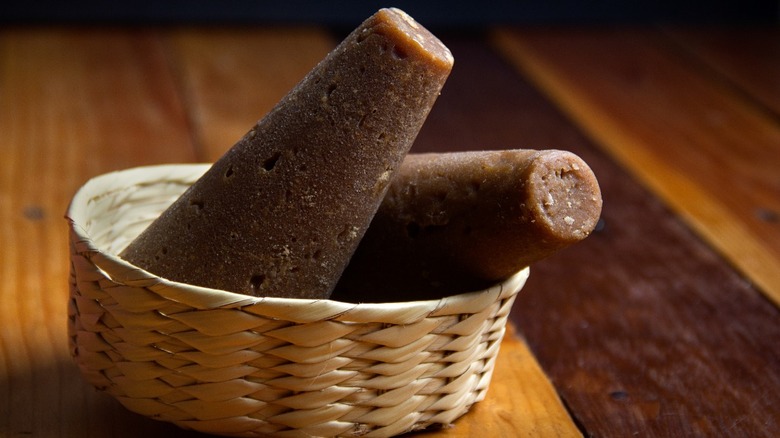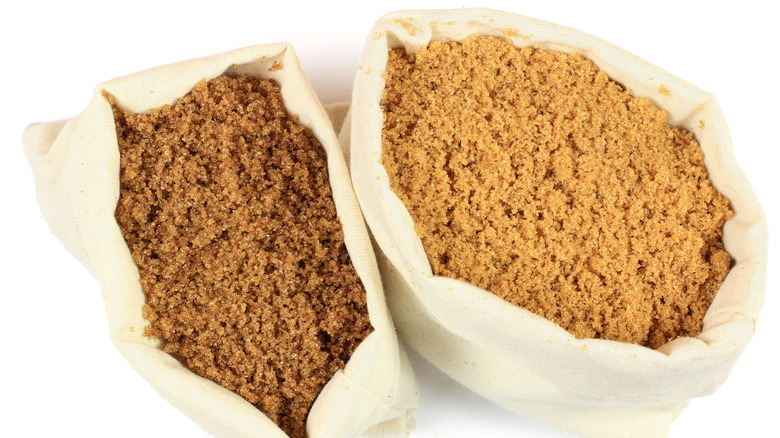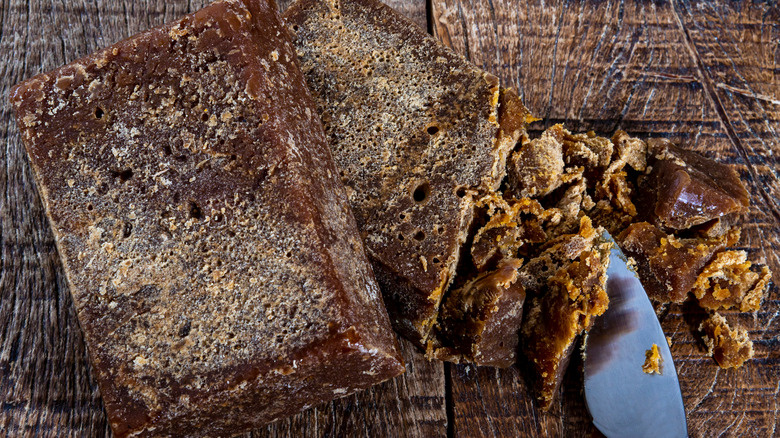Brown Sugar Vs. Piloncillo: What's The Difference?
Foodies can rejoice; the grocery store is becoming a more diverse space. According to Progressive Grocer, the multicultural grocery business is valued at roughly $50 billion — and counting. Multicultural families are expected to represent at least half the population of the United States by the midpoint of the 21st century, meaning the ethnic and international food aisles will only lengthen over time, per Progressive Grocer. However, cooks benefiting from this plethora of choices are running into a new quandary of navigating the nuances between culinary doppelgängers.
For bakers, perhaps no field is more diverse or crowded than that of alternative sweeteners and sugar substitutes. Take piloncillo, a product that has been colloquially dubbed "Mexican brown sugar" by some fans in the U.S. A quick scan shows their similarities in color, taste, and usage, but on closer examination, this somewhat reductive title proves to be a misnomer. What devilish details set these two sugar-based substances apart?
The brown sugar basics
According to Bon Appétit, brown sugar is refined white sugar combined with molasses, which is itself a byproduct of the sugar refinement process. Baking authority Rose Levy Beranbaum notes that the two main varieties you can find in the grocery store, dark and light, are decided by the amount of molasses added to the sugar (3.5% in light brown sugar and 6.5% in dark brown sugar). That crucial addition of molasses is what makes brown sugar so special in taste and texture: The Spruce Eats explains that it adds moisture, acidity, and caramel-like flavor to your baking and cooking. Over time, though, the water in the molasses will evaporate, creating the clumpy brown sugar that plagues the nightmares of bakers everywhere (per Bon Appétit).
Unlike turbinado, demerara, or cane sugar, brown sugar is a more highly refined sugar product (since its base is refined white sugar), meaning it's more processed and contains minimal nutrients, per The Spruce Eats. That brings us to our unrefined sugar waiting in the wings: Mexico's beloved piloncillo.
The pros of piloncillo
Also known as panela throughout Latin America, piloncillo is a Mexican staple. According to The Spruce Eats, to make this standby ingredient, sugar cane juice is boiled, reduced, and then poured into a conical or square mold to harden. Once unveiled, a rigid, tan structure of unrefined sugar — along with a number of vitamins and minerals, says Piloncillo Mex — remains.
Like its popular American counterpart, piloncillo comes in light (blanco) and dark (oscuro) varieties which use green and purple sugar cane, respectively. Due to its rigid shape, piloncillo is sold by the ounce and can take some finesse to incorporate into your food. Isabel Eats recommends you grate, chop, or simply melt your piloncillo as needed for your various recipes. As for taste, think of piloncillo as the mezcal of brown sugars, offering a delicately smoky flavor to your cooking; Serious Eats suggests using it on desserts that include rum or tequila, or as the perfect sugar in which to macerate fresh-cut fruit. On the savory side, incorporate a dash of piloncillo into chicken and pork rubs, or hot pots of chili.
Even with their key differences, brown sugar and piloncillo have enough in common to work as dupes in the kitchen. Gourmet Sleuth notes you can substitute dark brown sugar for piloncillo in a 1:1 ratio — so for those looking to explore all the delicious complexities sugar can offer, piloncillo is worth tracking down and getting on a first-name basis with.


